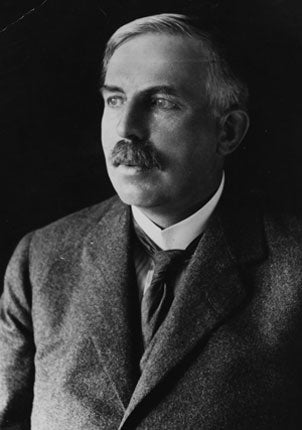The deadly legacy of room 2.62 – or just a cancerous coincidence?

He was the man who launched the world into the nuclear age, winning a Nobel prize and laying the foundations for modern nuclear physics.
But now it appears that radiation left over from 100-year-old experiments by Ernest Rutherford, the first man to split the atom, could be partly responsible for the deaths of up to four Manchester University staff.
For years between 1909 and 1917 Professor Rutherford conducted experiments in room 2.62 of an austere red-brick Victorian building which now bears his name. There he investigated the properties of radon and polonium – which killed the Russian dissident Alexander Litvinenko – and experiments using radioactive material were carried out there until 1947. But the building was never tested for radiation and in 1972 it was handed over to the university's psychology department.
Concerns about the building's safety were raised last year after the premature death of the psychologist Hugh Wagner, who died of cancer aged 62, having worked for 20 years in room 2.62.
His colleague John Clark, who worked in room 1.54, directly below Dr Wagner's room, succumbed to a brain tumour in 1993.
Then last week Arthur Reader, 69, who also worked in the Rutherford building, lost his battle against cancer, fuelling fears among his family that his death was "more than a coincidence". the Manchester Coroner Nigel Meadows has called for an inquest into his death. "I'm going to have a post-mortem examination to determine whether or not his death was unnatural – that is, whether or not he was exposed to anything during the course of his employment that may have caused or contributed to the cancer," he said.
There are also concerns over the death of Vanessa Santos-Leitao, who died from a brain tumour in February after being ill for less than a year.
The university insists there is no evidence of a causal ink between the building, which has been used by the psychology department since 1972, and the deaths. It insists it is safe – a view shared by the Health and Safety Executive.
However, a report by three academics working in the Rutherford Building has revealed a disquiet among workers there. Precautionary decontamination of the Rutherford was ordered in 1999 when staff began to find rooms and lecture theatres closed off with radiation warning signs.
The academics' report, which accepts there is no causal link established between the deaths and the building, has called for the thousands of members of staff who worked there to be traced if evidence of a health risk is uncovered. It said there continued to be uncertainty over the nature of the health risks to staff and called for a review of procedures governing workers' wellbeing.
In a statement, the university welcomed the academics' report and is set to announce details of its own independent inquiry into the affair, having come under pressure from the lecturers' union, the University and College Union. Sally Hunt, the union's general secretary, said: "UCU has been pressing the university to implement its proposal for an independent investigation into the concerns raised by staff as soon as possible. We also want to know whether the Health and Safety Executive took all the steps it should have."
The dangers of radioactive material were not fully understood by the pioneers in the field. Marie Curie died from leukaemia in 1934 while her notebooks are still too dangerous to handle. Rutherford died in 1937, aged 66.
Subscribe to Independent Premium to bookmark this article
Want to bookmark your favourite articles and stories to read or reference later? Start your Independent Premium subscription today.

Join our commenting forum
Join thought-provoking conversations, follow other Independent readers and see their replies